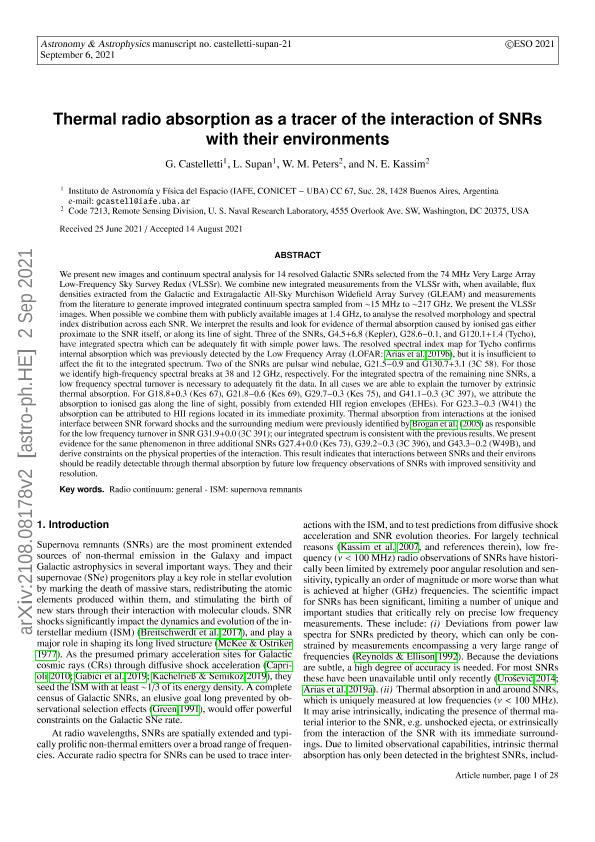Artículo
Thermal radio absorption as a tracer of the interaction of SNRs with their environments
Fecha de publicación:
09/2021
Editorial:
EDP Sciences
Revista:
Astronomy and Astrophysics
ISSN:
0004-6361
e-ISSN:
1432-0746
Idioma:
Inglés
Tipo de recurso:
Artículo publicado
Clasificación temática:
Resumen
We present new images and continuum spectral analysis for 14 resolved Galactic supernova remnants (SNRs) selected from the 74 MHz Very Large Array Low-Frequency Sky Survey Redux (VLSSr). We combine new integrated measurements from the VLSSr with, when available, flux densities extracted from the Galactic and Extragalactic All-Sky Murchison Widefield Array Survey and measurements from the literature to generate improved integrated continuum spectra sampled from ~15 MHz to ~217 GHz. We present the VLSSr images. When possible we combine them with publicly available images at 1.4 GHz, to analyse the resolved morphology and spectral index distribution across each SNR. We interpret the results and look for evidence of thermal absorption caused by ionised gas either proximate to the SNR itself, or along its line of sight. Three of the SNRs, G4.5+6.8 (Kepler), G28.6-0.1, and G120.1+1.4 (Tycho), have integrated spectra which can be adequately fit with simple power laws. The resolved spectral index map for Tycho confirms internal absorption which was previously detected by the Low Frequency Array, but it is insufficient to affect the fit to the integrated spectrum. Two of the SNRs are pulsar wind nebulae, G21.5-0.9 and G130.7+3.1 (3C 58). For those we identify high-frequency spectral breaks at 38 and 12 GHz, respectively. For the integrated spectra of the remaining nine SNRs, a low frequency spectral turnover is necessary to adequately fit the data. In all cases we are able to explain the turnover by extrinsic thermal absorption. For G18.8+0.3 (Kes 67), G21.8-0.6 (Kes 69), G29.7-0.3 (Kes 75), and G41.1-0.3 (3C 397), we attribute the absorption to ionised gas along the line of sight, possibly from extended H II region envelopes. For G23.3-0.3 (W41) the absorption can be attributed to H※ II regions located in its immediate proximity. Thermal absorption from interactions at the ionised interface between SNR forward shocks and the surrounding medium were previously identified as responsible for the low frequency turnover in SNR G31.9+0.0 (3C 391); our integrated spectrum is consistent with the previous results. We present evidence for the same phenomenon in three additional SNRs G27.4+0.0 (Kes 73), G39.2-0.3 (3C 396), and G43.3-0.2 (W49B), and derive constraints on the physical properties of the interaction. This result indicates that interactions between SNRs and their environs should be readily detectable through thermal absorption by future low frequency observations of SNRs with improved sensitivity and resolution.
Palabras clave:
ISM: SUPERNOVA REMNANTS
,
RADIO CONTINUUM: GENERAL
Archivos asociados
Licencia
Identificadores
Colecciones
Articulos(IAFE)
Articulos de INST.DE ASTRONOMIA Y FISICA DEL ESPACIO(I)
Articulos de INST.DE ASTRONOMIA Y FISICA DEL ESPACIO(I)
Citación
Castelletti, Gabriela Marta; Supán, Jorge Leonardo; Peters, W. M.; Kassim, N. E.; Thermal radio absorption as a tracer of the interaction of SNRs with their environments; EDP Sciences; Astronomy and Astrophysics; 653; 9-2021; 1-28
Compartir
Altmétricas




